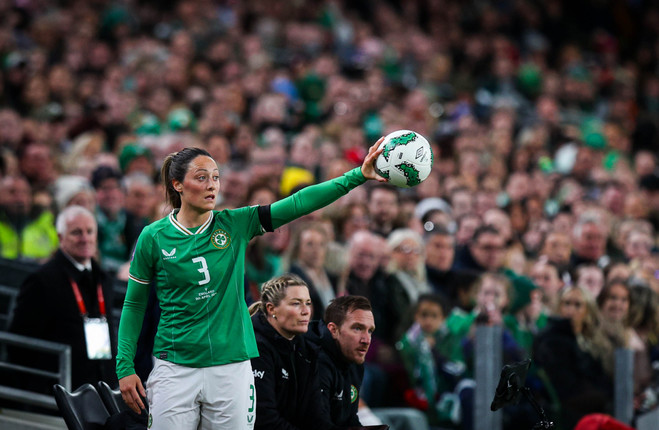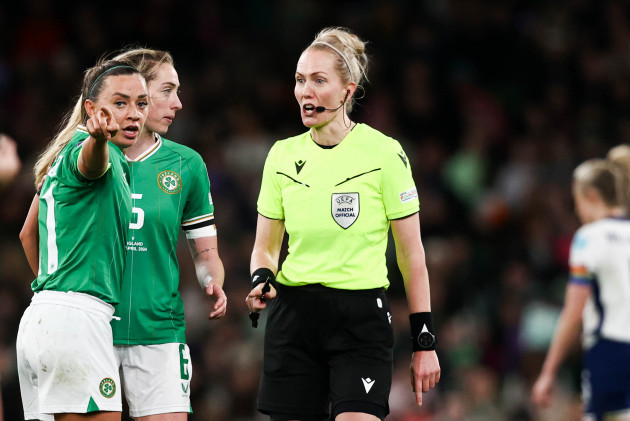AS LATE AS the 73rd minute last night, the statistics were bleak from an Irish perspective.
In addition to being 2-0 down against England at the Aviva, they officially had zero shots on target and zero off target.
Their possession was at 24%, albeit against a side ranked second in the world who had demonstrated impressive technical prowess and always seemed to have an extra player on the pitch.
Yet by the conclusion, even England boss Sarina Wiegman admitted her team, who had looked so comfortable for most of the game, were “struggling”.
In the end, Ireland had registered five shots (three on target) and moved their possession up to 30% amid a morale-boosting late rally.
So what changed?
***
One surefire way to wind up Ireland fans is by referring to their style of football as “British”.
It is a cliché regularly employed by opposition managers over the years during the customary question at press conferences for an upcoming game.
That said, last week France boss Hervé Renard managed to skilfully navigate this sensitive topic when asked by a journalist about Ireland’s “British style”.
“Ireland is an improving nation,” he said. “I won’t say they have a British identity — they have their own identity with a lot of combativity.”
But let’s consider the ‘British style’ connotations, for a moment.
The phrase is shorthand for direct football, kick and rush, putting the opposition under pressure by pressing high, bombarding their box with long balls and forcing them into aerial duals.
An Englishman, Jack Charlton, originally effectively introduced this style to the Irish international team.
Before then, during the reigns of John Giles and Eoin Hand, the side tried to play more constructively for the most part.
Since Charlton, the Irish men’s team have been playing a variation of this style until the Stephen Kenny era.
Kenny was the first manager since Charlton to aggressively push back against the notion that this approach was somehow tied to the country’s footballing DNA.
Nevertheless, given that the Irish teams of the late ’80s and early ’90s had success comparable to the English teams of that era, you could argue it deserves to be called an ‘Irish style’ as much as it does ‘British’.
Yet there is a tendency in modern times, which applies to the Irish men’s and women’s teams, whereby people want the national side to be perceived as sophisticated and at the cutting edge of top-level European football.
Playing out from the back is the style that’s in vogue, perpetual long balls less so.
So on Tuesday, Ireland spent over an hour trying to play with a degree of adventure, a counter-attacking style to catch England out.
Yet their opponents were too good. They had a similar enough approach but with technically superior players and consequently dominated proceedings for the entirety of the first half and a significant portion of the second.
Ireland had barely laid a glove on their rivals after an hour of football, but to their credit, Gleeson and the coaching staff recognised what they were doing was not working.
A more stubbornly idealistic coach might have persisted out of pride, but Ireland opted for plan B.
The catalyst was the 61st-minute introduction of Megan Campbell.
Almost immediately, the Drogheda native had a chance to produce one of her customary long throws. This simple action caused a palpable nervousness in an English defence that had coasted through the game until that point.
Ireland finally embraced this so-called ‘British’ style, which paid dividends to an extent.
Aside from Campbell, other changes were making an impact too.
Defender Louise Quinn was moved to centre-forward and her presence was an additional headache for the English backline.
Leanne Kiernan and Emily Murphy added pace and energy to the attack, while Megan Connolly was a steadying influence in midfield.
Ireland suddenly had an impetus and looked to be playing with purpose in contrast to the early parts of the game when they were so passive and toothless.
“They made it a real fight by putting players up front and the throw-ins, which were spectacular,” Wiegeman said afterwards. “We had to really fight in one v ones in the 18-yard box. It’s a lesson for us, if we win the ball, we really want to keep the ball and play out of the press and make our own momentum again, that’s what we struggled with a bit.”
Wiegeman continued: “As soon as they won the ball they wanted to go forward and play counter-attack [in the first half]. Later on, they changed that, they wanted to [play the percentages] and get the duels, so they put more players up front and really wanted to win those battles and second balls.”
So does Irish football need to fully embrace an extremely direct or ‘British’ style more consistently in future?
Not necessarily. Last night prompted more questions than answers. Part of Ireland’s second-half improvement undeniably resulted from English complacency as the visitors took their foot off the pedal, not demonstrating anywhere near the intensity and skill of the opening period.
Or as Wiegeman put it: “We kept giving them momentum.”
Moreover, how Ireland played for the final 20 minutes is hardly viable throughout the game. Putting Louise Quinn up top is fine when chasing an equaliser but this tactic would have seemed ridiculous at the outset yesterday.
Gleeson made a similar point: “We like being higher up the pitch, we like being more aggressive, but we have to see how long we can sustain that position. If we go 90 minutes with that, we’d be opened up earlier.”
Even selecting Campbell — the player who did more than anyone to shift the momentum in Ireland’s favour — is far from straightforward.
The 30-year-old London City Lionesses footballer has had a torrid time with injuries in recent seasons so her body must be carefully managed.
“She has a modified training programme and we have to follow that when she comes in,” Gleeson said. “We have to be very mindful of that and how many minutes she can get. Obviously, she has an impact when she comes on so we have to make sure she can stay fresh for the amount of time that we put her on for.”
Like Campbell, Ireland under Gleeson are a work in progress, a team still figuring out their identity.


